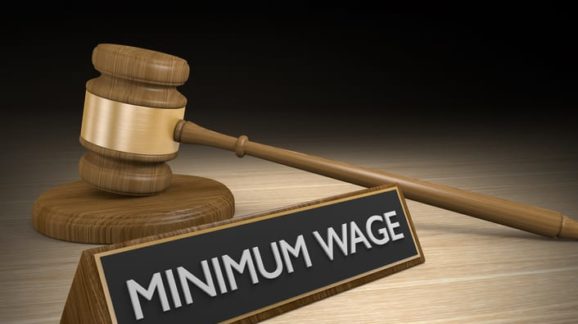For Small Businesses, Hiking Minimum Wages Now Is Like Throwing an Anchor to a Drowning Man

Photo Credit: Getty
 Three states and three major cities hiked up their minimum wages Wednesday, resisting calls by the business community to hold off until the COVID-19 crisis is under control. Advocates of a higher minimum wage typically argue that the positive benefits of these increases outweigh any drawbacks. But raising labor costs when the current unemployment rate is 13 percent and many businesses are struggling to find ways to stay open seems like a bad time to test that hypothesis. Given that most business are going to have radically rethink how they do business, they’ll need more flexibility on how they restructure. A high minimum wage does the exact opposite.
Three states and three major cities hiked up their minimum wages Wednesday, resisting calls by the business community to hold off until the COVID-19 crisis is under control. Advocates of a higher minimum wage typically argue that the positive benefits of these increases outweigh any drawbacks. But raising labor costs when the current unemployment rate is 13 percent and many businesses are struggling to find ways to stay open seems like a bad time to test that hypothesis. Given that most business are going to have radically rethink how they do business, they’ll need more flexibility on how they restructure. A high minimum wage does the exact opposite.
The federal minimum rate is $7.25 an hour, but states and cities are free to set their rates above that. The states that hiked their rates Wednesday are making fairly modest increases. Oregon’s main rate went up 50 cents to $11.50 an hour, and a secondary rate for larger businesses rose 75 cents to $13.25. Nevada hiked its rate for workers with qualified health benefits to $8 per hour and $9 per hour for those without, an increase of 75 cents in both cases. Illinois increased its rate to $10, up 75 cents.
The cities are being more radical. Chicago’s minimum wage is now $14, up a dollar. Minneapolis raised its rate to $11.75, up 75 cents, for small businesses and $13.25, up a dollar, for large businesses. Washington D.C.’s rate is now $15, also up a dollar.
Others are being more cautious. Virginia was set to raise its rate to $9.50, up from $7.25, at the beginning of next year, but earlier this year the general assembly voted to postpone the increase to May. “While I want to make sure we’re taking care of our workers across Virginia, I also want to make sure we come out of this economic crisis in as strong a position as I can,” Governor Ralph Northam, a Democrat, said in April.
The two arguments most frequently used by minimum wage boosters is that most bottom rates aren’t something a person can live on and that increases are the best way to put money into the pockets of the poorest individuals. Both points are true but neither automatically translates into minimum wage hikes being a good idea.
For one thing, the increases only help the people still working. The Congressional Budget Office estimated last year that setting the federal rate to $15 would result in 1.3 million workers losing jobs. “Small businesses are far less likely than larger businesses to have cash reserves or profit margins to absorb the increase in labor costs,” noted the National Federation of Independent Business, the main small business trade association.
The reality is that both employers and workers need flexibility in order to set the terms of employment. Sure, big employers like Walmart and Costco and Amazon and Target and others can afford a high minimum wage, but does this really translate to the corner store, the local deli, or the dry cleaners? You know, the struggling small businesses that would employ some local teenagers to make deliveries or stock shelves?
About third of all minimum wage earners are between 16 and 19 years old and nearly 60 percent are between 16 and 24. The stereotype of a minimum wage worker being a teenager flipping burgers exists for a reason. Some states and cities have grappled with this setting by multiple different rates, as in the case of Oregon. This process typically results in a lot of additional lobbying over who gets included in these exceptions. The same people who decry the influence of lobbyists in legislatures have a curious habit of giving those same lobbyists more reasons to lobby lawmakers in the first place.
To a large extent, the tight labor market prior to the COVID-19 outbreak was making the need for higher minimum wages unnecessary. Walmart announced in 2018 that it was sitting its starting wage at $11 an hour, a bid to hold and keep employees at its stores. Other large employers have made similar announcements. Wages had been rising about 4 percent a year since 2018, and the pre-outbreak unemployment rate fell to just 3.5 percent in February. Only about 0.4 percent of the overall increase in wages can be attributed to higher minimum wages. Mostly, it was employers offering higher salaries because that’s what the job market demanded. It’s also worth noting that those statistics don’t include the number of people who lost jobs because employers couldn’t afford the higher rates. Those people don’t show up in the statistics.
Again, the current rate nationally is 13 percent. While that is well below the gloomier predictions that came out at the outset of the outbreak, it’s still a staggering number. We’re facing a situation where employers have taken it on the chin for months, being forced to shut down and burn through savings to stay open. To stay afloat despite COVID-19, they’ll have to restructure their businesses. Forcing them to pay rates higher than what they may be able to afford is not helping them. And if they cannot stay open, then they can’t hire anyone.